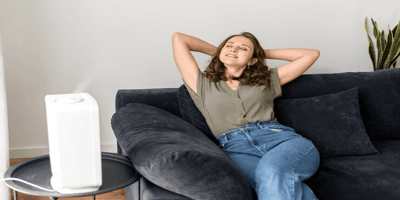Pet Allergies and Pet Hair: How Effective Are Air Purifiers?
For countless individuals, the bond between humans and their beloved pets is an enduring source of joy and companionship. However, this heartwarming connection can sometimes come at a cost—pet allergies. Allergic reactions to pets, particularly cats and dogs, are a common concern for households with furry friends. These allergies can manifest in symptoms like sneezing, itching, watery eyes, and more, making life less comfortable for both pet owners and their four-legged companions.
One of the primary culprits behind pet allergies is often pet hair, which can carry allergens such as pet dander, saliva, and even microscopic particles from the outdoors into your living space. As pet hair settles on surfaces and becomes airborne, it becomes a potential trigger for allergic reactions, especially in those with sensitivities.
In response to this challenge, a growing number of pet owners are turning to a promising solution: air purifiers. These devices have surged in popularity as a means to combat pet-related allergens and create a healthier indoor environment. They offer the promise of cleaner, allergen-reduced air, potentially alleviating the discomfort of pet allergies and allowing households to enjoy the presence of their furry family members without constant sneezing fits or itching eyes.
In this article, we will delve into the intriguing intersection of pet allergies and pet hair, exploring the role that pet hair plays in exacerbating allergies and examining how home air purifiers have gained prominence as a promising tool in the battle against pet-related allergens. We'll consider the mechanics of air purifiers, their effectiveness in addressing pet hair and allergens, and the factors to ponder when choosing one for your pet-friendly home. So, if you share your life with a furry companion and seek relief from pet allergies, read on to discover whether air purifiers might be the solution you've been searching for.
Understanding Pet Allergies
Pet allergies are a common and often misunderstood health concern that affect millions of individuals worldwide. These allergies arise when the immune system responds to specific proteins or allergens found in the bodies of pets, primarily cats and dogs. While pets bring joy, companionship, and unconditional love to our lives, for some people, they can also bring a host of allergy symptoms and discomfort.
What Are Pet Allergies?
Pet allergies are a type of allergic reaction triggered by exposure to proteins found in the skin cells, urine, saliva, and hair of cats and dogs, although other animals like birds, rabbits, and rodents can also be allergenic. These proteins, commonly referred to as allergens, can provoke an immune response in susceptible individuals. When the immune system identifies these allergens as harmful invaders, it releases histamines and other chemicals to fight them off. This immune response leads to a range of allergy symptoms that can vary in severity.
How Pet Allergies Affect Individuals:
Pet allergies can manifest in a variety of symptoms, including:
- Sneezing: Frequent sneezing is a common allergic reaction to pet allergens.
- Runny or Stuffy Nose: Allergies can cause nasal congestion or a runny nose.
- Itchy, Watery Eyes: Allergic conjunctivitis can lead to itchy, red, and watery eyes.
- Skin Rash: Some individuals may develop hives or a skin rash upon contact with pet allergens.
- Coughing and Wheezing: Allergies can lead to coughing and wheezing, especially in those with asthma.
- Shortness of Breath: Severe allergies may result in difficulty breathing, known as anaphylaxis (though this is less common with pet allergies).
It's important to note that pet allergies can be particularly challenging for individuals with preexisting respiratory conditions like asthma, as exposure to pet allergens can exacerbate these conditions and lead to more severe symptoms.
Common Allergens Produced by Pets:
Pet allergens primarily originate from proteins found in pet dander, saliva, urine, and, notably, pet hair. Understanding these common allergens is key to managing pet allergies effectively:
- Pet Dander: Pet dander consists of tiny, often microscopic, flecks of skin shed by cats, dogs, and other animals. When these particles become airborne, they can trigger allergic reactions.
- Pet Saliva: Allergic reactions can occur when individuals come into contact with pet saliva, either directly through petting or indirectly through surfaces licked by animals.
- Pet Urine: While less common, allergenic proteins can be present in pet urine, making it another potential source of allergen exposure.
- Pet Hair: While pet hair itself is not an allergen, it can carry and trap allergens like pet dander, making it a vector for allergen dispersal in the home.
The Role of Pet Hair in Allergies
Pet hair, while not an allergen itself, plays a significant role in exacerbating allergies for some individuals, particularly those who are sensitive to pet allergens. Understanding why pet hair can be a substantial allergen and how it contributes to allergic reactions is essential for effectively managing pet-related allergies.
Why Pet Hair Can Be a Significant Allergen:
- Carrying Allergens: Pet hair, like a furry vehicle, can carry and transport allergenic particles. When pets groom themselves, allergens such as pet dander and saliva can become attached to their fur. As a result, pet hair can become laden with these allergenic substances.
- Airborne Distribution: Pet hair readily sheds and becomes airborne, especially in homes with active pets. When pet owners interact with their animals by petting or cuddling, pet hair becomes dislodged and can scatter throughout the environment.
- Static Electricity: Pet hair has a natural affinity for static electricity, allowing it to cling to various surfaces, including clothing, upholstery, curtains, and bedding. This static charge can make it challenging to remove pet hair from the indoor environment.
- Inhalation: Once airborne, pet hair can be inhaled by individuals, even those without pet allergies. However, for those with sensitivities to pet allergens, inhaling pet hair can introduce allergenic proteins like pet dander and saliva into the respiratory system.
How Pet Hair Can Trap Other Allergens:
Pet hair doesn't just transport allergens; it can also serve as a trap for other airborne particles, compounding its role in allergies:
- Pet Dander: Pet dander consists of tiny skin flakes shed by animals, and it is a common allergen. When pet dander becomes airborne, it can attach to pet hair, effectively "hitching a ride" and making it more likely to be inhaled by individuals.
- Dust and Pollen: Pet hair can also trap dust, pollen, and other airborne particles that can trigger or worsen allergies. These particles can accumulate on pet hair surfaces and be stirred up when disturbed, leading to increased allergen exposure.
In essence, pet hair acts as a vehicle that transports allergenic particles, making them more accessible for inhalation by individuals. This can lead to a heightened allergic response, causing symptoms such as sneezing, itching, and respiratory discomfort, especially in those who are already sensitive to pet allergens.
Air Purifiers vs. Pet Hair. Can an Air Purifier Remove Cat Hair?
When it comes to managing pet hair and related allergens in your home, air purifiers can be a valuable tool in your arsenal. They play a crucial role in improving indoor air quality by removing airborne particles, but how effective are they in tackling pet hair specifically, and how do they complement other pet hair removal methods like vacuuming and grooming? Let's explore the benefits of air purifiers in relation to pet hair:
Effectiveness in Removing Pet Hair from the Air:
- Particle Filtration: High-quality air purifiers are equipped with filters that are specifically designed to capture airborne particles, including pet hair. HEPA (High Efficiency Particulate Air) filters, in particular, are known for their exceptional ability to trap particles as small as 0.3 microns, which includes pet hair.
- Continuous Filtration: Air purifiers run continuously, ensuring that as long as your pet's hair is airborne, the purifier will work to capture it. This is especially useful in homes with shedding pets, as it provides ongoing relief from airborne pet hair.
- Reduced Allergen Load: Pet hair often carries allergens like pet dander and saliva. By removing pet hair from the air, air purifiers can also help reduce allergen exposure, alleviating allergic reactions in sensitive individuals.
Complementing Other Pet Hair Removal Methods:
While air purifiers are effective in capturing pet hair from the air, they are most effective when used in conjunction with other pet hair removal methods:
- Vacuuming: Regular vacuuming with a vacuum cleaner equipped with a HEPA filter is essential for removing pet hair from carpets, floors, and upholstery. Vacuuming not only targets hair that has settled on surfaces but also reduces the overall amount of pet hair in your home, lessening the load on your air purifier.
- Grooming: Regular grooming of your pets can significantly reduce the amount of loose hair they shed. Brushing and bathing your pets not only improve their coat health but also prevent excessive shedding, resulting in less pet hair in the environment.
- Air Purification: Air purifiers complement vacuuming and grooming by addressing the pet hair that becomes airborne. Even with meticulous cleaning and grooming, some pet hair will inevitably become airborne through pet movement and daily activities. Air purifiers work continuously to capture these airborne particles, reducing allergen exposure.
- Maintenance: It's important to remember that both vacuum cleaners and air purifiers require maintenance. Regularly changing vacuum cleaner bags or filters and cleaning or replacing the filters in your air purifier is essential to ensure their continued effectiveness.
Air Purifiers vs. Pet Allergens
For individuals with pet allergies, the presence of pet allergens like dander, saliva, and urine in their homes can lead to discomfort and respiratory issues. Air purifiers are often recommended as a means to reduce these allergens and improve indoor air quality. Let's explore the effectiveness of air purifiers in reducing pet allergens, particularly pet dander, and consider studies or research that support these claims:
Effectiveness in Reducing Pet Allergens, Especially Dander:
- Particle Filtration: High-quality air purifiers are equipped with HEPA filters, which are specifically designed to capture tiny particles, including pet dander. HEPA filters can trap particles as small as 0.3 microns with an efficiency of 99.97%, making them highly effective in removing allergens from the air.
- Continuous Filtration: Air purifiers operate continuously, ensuring that they can capture pet allergens as they become airborne. This is particularly important for pet owners, as allergens like dander can be stirred up into the air by pet movements and activities.
- Reduced Allergen Load: By removing pet allergens from the air, air purifiers help reduce the overall allergen load in your home. This reduction can lead to fewer allergen particles settling on surfaces and being inhaled by occupants, ultimately providing relief from allergy symptoms.
Studies and Research Supporting Air Purifier Claims:
Several studies and research efforts have examined the efficacy of air purifiers in reducing pet allergens and alleviating allergy symptoms:
- American Journal of Rhinology and Allergy (2005): A study published in this journal found that the use of HEPA air purifiers led to a significant reduction in indoor pet allergen levels, including pet dander. Participants reported improved allergy symptoms and better overall comfort.
- Journal of Allergy and Clinical Immunology (2002): Research published in this journal demonstrated that the use of HEPA air purifiers effectively reduced airborne cat allergen concentrations in homes with cat-allergic individuals. The study concluded that air purifiers could be a valuable tool in managing pet allergies.
- Indoor Air Journal (2004): A study published in this journal assessed the impact of air purifiers on indoor cat allergen levels. The researchers found that air purifiers equipped with HEPA filters were effective in reducing cat allergen levels in homes, providing relief to individuals with cat allergies.
- Asthma and Allergy Foundation of America (AAFA): The AAFA recommends the use of HEPA air purifiers as part of a comprehensive allergy management plan, particularly for pet allergies. They emphasize the importance of continuous air purification to maintain lower allergen levels.
While these studies and recommendations support the claims of air purifiers in reducing pet allergens like dander, it's important to note that the effectiveness of an air purifier can vary based on factors such as the type of purifier, the size of the room, and the level of allergen exposure. However, when used correctly and in conjunction with other allergen-reduction strategies like regular cleaning and grooming of pets, air purifiers can be a valuable tool for individuals seeking relief from pet allergies and improved indoor air quality.
Sensibo Air Purifier
The Sensibo purifier presents itself as a commendable option when it comes to combatting pet hair in your home. It offers several features and advantages that make it an attractive choice for pet owners looking to manage pet hair effectively:
- HEPA Filtration: The Sensibo purifier typically includes HEPA (High Efficiency Particulate Air) filters, which are renowned for their effectiveness in capturing small particles, including pet hair. These filters can trap pet hair as it becomes airborne, reducing the amount that settles on surfaces and potentially aggravates allergies.
- Continuous Operation: Sensibo purifiers are designed to run continuously, which is particularly advantageous in homes with shedding pets. By operating continuously, they can capture pet hair as it's dispersed into the air, maintaining cleaner and allergen-reduced air throughout the day and night.
- Customizable Settings: Many Sensibo purifiers come equipped with customizable settings, allowing you to tailor the purifier's operation to your specific needs. You can adjust the fan speed and filtration settings to optimize the removal of pet hair and other allergens from the air.
- Smart Features: Sensibo purifiers often offer smart features, allowing you to control the device remotely through a smartphone app. This can be beneficial for pet owners who want to monitor and adjust their purifier's operation when they are away from home, ensuring constant allergen reduction.
In the quest to create a harmonious home environment for both pets and allergy-prone individuals, the role of air purifiers in tackling pet allergies and pet hair is undeniably promising. Throughout this exploration, we've seen that air purifiers, especially those equipped with HEPA filters, offer effective means to reduce pet allergens, including pet dander and hair, in the air.


































.jpg)



.png?height=200&name=image5%20(1).png)